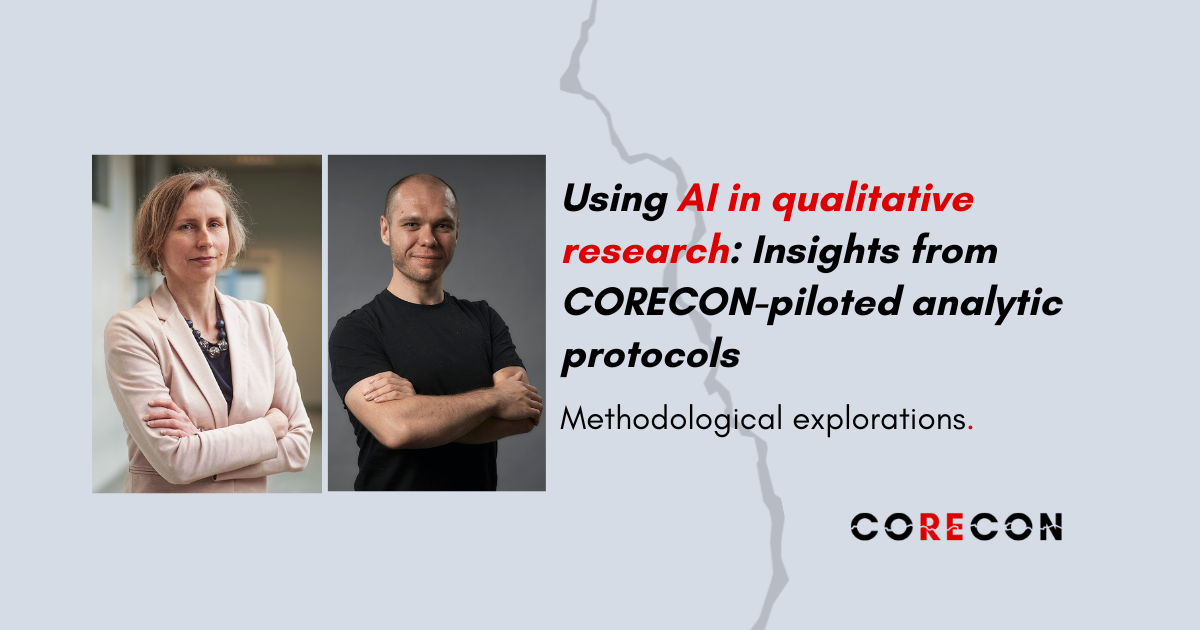This blogpost is devoted to exemplifying how it is possible to ethically and productively use AI-powered tools in order to enhance analytic protocols for qualitative analyses of media materials.
AI-powered enhancements designed for annotating, coding and analyzing textual data are now part of commercial versions of qualitative analysis software packages such as Atlas.ti or NVivo. Yet, it is possible to test their applications in a limited way with regard to a restricted sample of textual material. It is worth testing the affordances of the application first, as, depending on the languages used in the dataset, the results of some piloted analyses with AI-tools may vary from satisfactory (for English) to disappointing (for Polish).
New opportunities to use AI to code and pre-analyze data
One task for which it is worth piloting the AI-powered tools of your choice is automatic coding (e.g., available in Atlas.ti based on ChatGPT model from OpenAI). This function can be useful for initial exploratory coding of recurrent themes or patterns in the dataset, which may resemble doing topic modelling (see our previous blog post on topic modelling here). Explore the option for intentional coding if you have a specific research question that should drive and inform the creation of codes. When you are manually coding material, AI can also assist you by suggesting possible codes that may adequately reflect the content of the texts in the dataset. This is based on previous codes used in the application, the summary of text, and newly generated cues. The codes can be verified and amended at all times, so the analyst retains the ultimate control over the coding process.
Any LLM-based AI application can be useful for exploration (distance reading) of large textual datasets. It can help you summarize larger pieces and offer preliminary hierarches of themes (as we did in a CORECON study). This is particularly useful when the inductive analysis needs to be streamlined, and decisions what to attend to and what to leave out of the research report need to be made.
In terms of close reading, AI applications can help you identify patterns and characteristics in sample texts as in the case of conversational AI in Atlas.ti. If you have a corpus of uploaded data, you can talk to the chatbot about all of the documents or some of them. For example, with a corpus of interviews with chosen candidates in Polish presidential elections 2025, we tried such prompts as “What topics are prevalent in the documents?” “What do speakers say about war in Ukraine?” “What stance does the speaker take towards Russia?” “What rhetorical/eristic strategies does the speakers use?”. The material was in Polish, but the results were satisfactory as for the initial exploration of the content of the research material. The answers contained a list of topics with short descriptions and references to quotations from the material. Unfortunately, concrete references to excerpts from the text were sometimes disappointing and irrelevant to the initial prompt.
Finally, interactions with a chatbot can be helpful in categorizing the codes in clusters and reducing their number, or in narrowing down the analysis to the most promising parameters. ChatGPT, for example, can be prompted to identify potential relations and hierarchies between the codes. After creating codes inductively – whether manually or with AI support – you can ask ChatGPT to group them into thematic streams and compare its output with your own grouping. In one of our pilot analyses we created over 700 codes, grouped them into 26 main themes, and 21 sub-themes. We also pasted the raw codes into conversational AI, with a short explanation of the project’s aim and the coding strategy. The model returned 6 main themes and 16 sub-themes, most overlapping with our manual groups, though the labels differed. In some areas, our taxonomy proved to be more useful; in others, the AI’s was surprisingly handy. Hybrid workflows – AI with a human in the loop – seem to give the best results.
Inspiration and cross-reference
Conversational AI may be useful in refining your coding and analyzing strategies, especially when the chatbot, guided by detailed prompts, supports you in coming up with interesting research questions based on the content of pre-selected datasets. This can help to identify preliminary codes to test as well as to highlight further analytic steps and strategies given the nature of the dataset at hand. For example, if you study media framing of Ukrainians, tell the chatbot what material you have uploaded, what the context of your study is, and specify what you would like to achieve. If you use ChatGPT, you can upload the dataset in CSV format and ask: “Here is the dataset of media texts on Ukrainians, collected from Polish online media outlets. Generate five specific research questions about framing the Ukrainians in these outlets. Propose initial codebook that I can test in Atlas.ti”.
AI can also enable sentiment analysis (for the texts in English) by offering summative information on the tone of the text, or by identifying specific sentiment parameters. The quality of this analysis can be compared to some well-established corpus linguistic tools for sentiment analysis; however, it is not always transparent how generative AI identifies certain parameters. For more detailed analyses, AI chatbot can also be asked to code for specific expression of stance or emotion. Remember to make it compatible with operationalizations that are established in the literature on the subject.
Risks and issues for qualitative researchers
The testing versions of some AI tools may still be problematic as to the quality of language-specific outputs: it is not uncommon for the results of automatic coding to be provided in a mix of languages, especially if your data are in various languages, as in CORECON.
Since the providers of AI-based tools are not transparent about how the algorithms were trained and how the codes are generated, as an analyst, you are not able to fully account for the results of automated coding protocols and you have to keep double-checking your coding schemes. Also the application might use your previous prompts, questions or tasks to refine the subsequent results, so another person coding the same material, with a different history of interactions with AI, might end up with different results.
Additionally, generative AI may not be very good at spotting culture-specific references, unique contextual constraints on texts, as well as figurative or ironic meaning. Perhaps it is better for you to avoid AI when analyzing texts with a high saturation of such textual characteristics. The tool may be relatively unhelpful when confronted with very diverse or unique texts analyzed with very specific needs in mind, as it is impossible to communicate these needs to a non-customizable AI application.
Final remarks
As AI-generated outputs are data-driven (and not so much theory-informed unless we feed theory into them) they can sway the results of qualitative analyses towards textual meanings not communicative intentions and effects. You need to keep this limitation in mind and take the AI-generated responses, codes and analytic observations with a pinch of salt. If you want more theoretical weight you can construct your prompt to take it into consideration. However, always remember it is based on the information it was trained with. The meanings of the concepts might vary from those you take in your research, so maybe you should provide a definition. The more specific prompt you construct – the better results you obtain.
All in all, AI is not there to replace you as an analyst – it should inspire you to explore and experiment with various approaches to your data, or verify and confirm your initial hunches.
For example, try comparing your own inductive coding of a representative sample with the one obtained through ChatGPT and see the level of overlap (if any). Maintain the control over the analytic process, as it is you who needs to build the argument and make an original discovery. If AI were to make those for us, all qualitative analyses based on human intuitions, synthetic observations and culture-specific experiences of meaning-making would be rendered irrelevant.
Text by Marcin Deutschmann and Katarzyna Molek-Kozakowska





